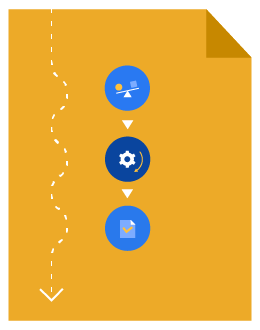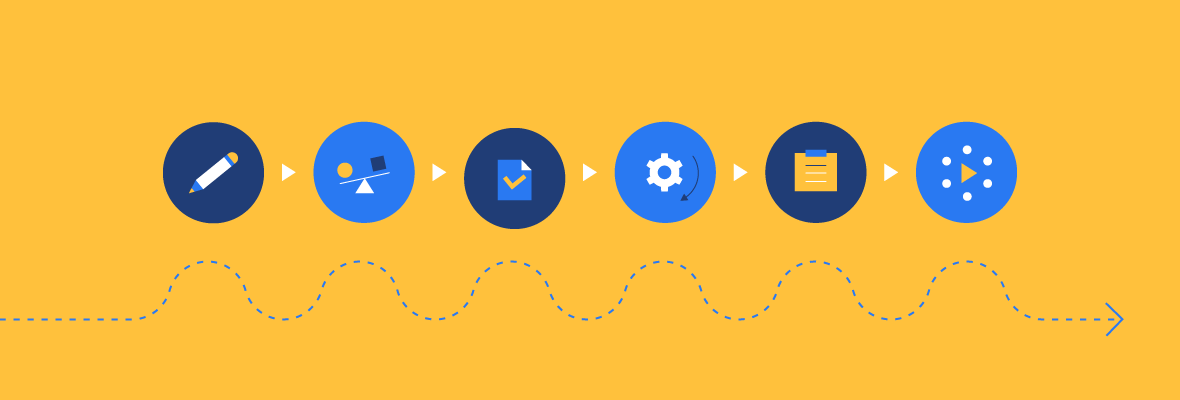At EBQ, we approach every marketing strategy by first understanding what each step of the buyer’s journey looks like for a particular company’s sales cycle. Knowing how your buyers travel down the sales funnel is crucial to building an automation strategy that saves time while nurturing prospects effectively.
The B2B buyer’s journey generally comprises 5 main stages—marketing goals throughout the journey range from generating initial awareness to retaining existing customers.
Here’s a brief overview of what buyers do in each stage of their journey and what marketers should be doing to convert them:
Stages of the buyer's journey
Awareness
In this stage, the buyer has a problem that needs to be solved, and your service or product can solve it! However, the buyer does not know about your solution or other alternatives yet. The strategy for this stage is to educate the buyer about their problem and slowly generate interest in your product as a solution.
Consideration
Next is the stage where the buyer weighs out pros and cons of your solution to their problem, as well as your competitors and other alternatives. This is where your company needs to show them what your product could provide and why you are better than your competitors.
Decision
Here is where your prospect makes the decision to buy or not. This is when you should focus on converting your prospects by providing content like case studies which will outline the value of your solution.
Growth
As your customer in this stage goes through the experience of adopting your solution, look for opportunities to provide guidance and to upsell and cross-sell, which will add value to the growing relationship between your company and the customer.
Delight
Lastly, this is where your goal is to delight your customer through different types of content to promote brand loyalty. This stage is where you help customers understand the level of support your company provides, which can determine whether they will become a regular user of your product or service.
Learn more about mapping out tactics for each stage of the buyer’s journey with our free walk-through and funnel template.

Marketing automation strategies
Now that we’ve covered the basics of the buyer’s journey, let’s talk about how to implement marketing automation strategies to help your brand engage and interact with prospects and customers throughout their journey.
Email automation strategies
The wide versatility of email platforms, with capabilities such as targeting different audiences, creating different triggers, and varied life cycle lengths, means that you can have different types of drip campaigns that react distinctly to your unique audiences.
Drip campaigns are generally a series of lifecycle emails that are automatically sent out on a schedule within your email marketing platform. You can also establish triggers that are set based on the actions and behaviors of your audience.

Types of drip email campaigns
Welcome series
This type of campaign is for new prospects and subscribers in the awareness and consideration stages. It’s your opportunity to teach them about your brand and expertise, and provide value to encourage them to continue engaging with your emails.
Educational content
Showcase your industry expertise by sending prospects relevant marketing content that explores a certain topic related to your offering and educates them on their business challenges.
Events & webinars
Inform prospects about upcoming in-person or virtual events you are hosting or attending. These campaigns are particularly enticing for consideration-stage prospects and an opportunity for you to engage them directly.
Product demo
These campaigns have a primary goal of getting prospects to participate in a product demonstration or other type of sales call. These emails are most effective for buyers in the decision stage who are open to learning more about your solution.
Promotional
Promo campaigns typically include some type of exclusive offer or discount, or otherwise educate prospects directly about your product to keep your brand top-of-mind.
Re-engagement
Retarget past customers and cold leads who have not engaged with your brand in a while. Remind these prospects why your solution is the best option and/or why they previously decided on your solution.
Website automation strategies
When users visit your website, there are a variety of ways to better understand and engage them through the use of automation.
One of those methods is by gating valuable content and setting up triggers through forms and downloads that require visitors to provide contact information and leads them further down the marketing funnel. Typically this is done through content like case studies, PDFs, or newsletter sign-ups.
You can learn a lot about prospects based on the type of content or form they convert through:
- Blog subscription: These prospects find your content valuable and want to continue learning through your expertise.
- Content downloads: you can identify prospect needs and interests based on the topics of content download.
- Case study/whitepaper downloads: These assets directly educate prospects about your product, so you can infer some level of purchase intent and pinpoint which solution they’re interested in.
- Contact form submission: These prospects are openly requesting more information about your product and/or to speak with your team. They are typically the most valuable and warm prospects to convert through your site.
When prospects reach out or sign up for this information, you can then add them to specific lists and send them follow-up emails for further outreach.
To go a step further, you can also utilize cookies when prospects visit your website to track behavior, personalize outreach, and score interaction via your CMS.

Download the B2B Guide to Marketing Automation
Don’t have time to read the whole guide right now? Download the PDF version of the guide.
Social media automation strategies
As we discussed in the previous chapter, social media automation allows your marketing team to plan out new posts and content in advance, as well as recycling important older content when needed.
Posting a wide variety of content on social media makes your brand’s feed more interesting and is more likely to capture your followers’ attention.
Examples of engaging social media posts include:
- Educational blog content to showcase expertise and thought leadership
- Customer case studies to demonstrate how exactly your help customers
- Company accolades to build credibility and gain industry recognition
- Company announcements to highlight happenings in your organization
- New product releases to keep your audience up-to-date on what you offer
- Company culture posts that humanize your brand and engage employees
That’s a lot of content to navigate, but social media automation makes executing a multi-faceted social strategy much easier. By strategizing and planning in advance, you can ensure your posts align with the needs of your audience in each stage of their buyer’s journey.
Marketing automation best practices
As an outsourced marketing firm, we have managed a wide range of automation platforms for clients and helped them overcome a variety of marketing automation challenges.
We want to close out this guide with some expert best practices, based on our years of experience, to help you perfect your own automation strategy.
1. Determine a master labeling system
We find that one key factor to any successful automation strategy is to stay organized. Creating a labeling system will help organize your workflow for collaborators to easily move forward with the project. Integrating your automation apps through APIs, with a tool like Zapier, is a helpful way to ensure all the different platforms you use are synchronized and organized.
2. Map your lead flow
Plan out the different conversion points along your buyer’s journey and the marketing content, assets, and messaging that will nudge them to the next stage. This allows you to deliver emails and content with precise timing.
3. Deliver relevant, targeted content
As your buyers move through the funnel, their needs and mindset change. Use indicators like site behavior, past form submissions, and custom prospect fields to send them the most relevant content for their interests and be sure you’re providing value.
4. Prioritize sender reputation and deliverability
Don’t let your emails end up in spam folders, or even worse, get your domain blacklisted. Avoid these issues by only emailing people who have opted in and by warming up your IP with small sends before emailing large groups of recipients. Additionally, remember that each email you send out is representative of your brand. It’s important that your messages are clear, effective, and consistent.
5. Clearly outline your lead generation strategy
Define exactly how and when a prospect converts to marketing-qualified (and eventually to sales-qualified). Use features like lead scoring to track the incremental steps needed to convert prospects and rank leads by interest level and product fit. This will help both marketing and sales exponentially.
6. Align sales and marketing using a CRM
Lastly, ensure that both your marketing and sales teams understand and are aware of the automated processes you’ve set up. By integrating your MA and CRM tools, you can keep sales in the loop on how leads are generated and how they interact with marketing assets. Transparency between sales and marketing allows for closer collaboration and keeps your complete sales funnel operating smoothly.
Optimize, optimize, and then optimize some more
Once you have planned and implemented your marketing automation strategy, it’s time to optimize! To be successful, you need to continuously edit and tweak your campaigns.
Let campaigns run for a few months, then gather metrics, assess performance, and implement what you learned. Continue doing this to create an optimal marketing cadence.
Consider reaching out to trusted customers and asking what their experience was with initial interactions with your brand. Customer feedback can be invaluable for editing and improving your outreach.
One thing to be mindful of here is to make sure that you are looking at useful metrics. While vanity metrics such as social media likes can tell you what content resonated with your audience, it won’t directly tell you much about your return on investment.
Be sure to pay attention to numbers that are more related to marketing’s impact on revenue, such as number of leads generated, opportunities converted, and revenue won.


